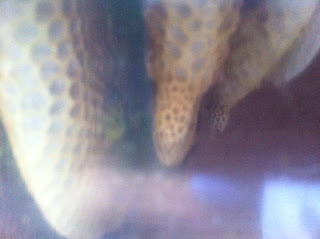It seems I was wrong about the reason for the number of drones outside my hive a few days ago - they weren't being kicked out after all, but were more likely there for another purpose. Drones can often be seen around a hive when the Queen is about to swarm. A couple of days after seeing all the drones I looked through the obbservation window and noticed some swarm cells had been built. These are long peanut shaped queen cells which hang from the bottom of the comb. There are three types of queen cells: swarm cells, supercedure cells and emergency cells. Supercedure cells are generally built in the middle of the comb rather than at the bottom, and are for when the bees intend to replace their queen. Emergency cells are generally ordinary worker cells which have been built up into queen cells in an emergency situation where the queen has been killed or injured. Very young worker larvae can then be fed up with royal jelly and developed into queens. I was rather concerned about this as it is very late in the season for swarming. I thought that the swarm cells had just been built, as I hadn't noticed them before, but on closer inspection I noticed that some were capped and two had already hatched out. As the weather was cold and wet I didn't want to do a full inspection of the hive, but lifted about 4 combs at the back of the hive to inspect. I saw a queen on the innermost comb I inspected, but am not sure if she was my original queen or a new virgin queen. I was also quite alarmed to see that there was hardly any honey in any of the combs, some of which had been full of honey on my last inspection. Lots of bees had their heads inside cells, as if looking for food and I was worried that the bees were starving. Bees were also clustered together all at the top of combs. I wondered then if the colony was starving and that the queen making was emergency behaviour. The bees had used up all of the sugar syrup/herbal tea mix I had put in a few days earlier, so I gave them some more. There also appeared to be less bees in the hive, but I would be expecting them to be reducing in numbers for the winter now. I did wonder though, whether my old queen has already swarmed, taking half the colony and much of the honey with her.
When I got up this morning and went to look at the hive, I happened to look up into a tree overhanging the apiary, and hanging from it in a high branch, was a swarm of bees!
It looked like quite a small swarm, and may well have been a cast. I called my man for help, got him to don a beesuit and together, armed with ladder, seceteurs and a cardboard box, we went to collect the swarm. We managed to shake most of the bees into the box, but there were a significant number flying around as well as small patches of bees in the tree, on the wall and on the ground.
I noted though, that a number of bees in the box began fanning, which is a good indicator that the queen was in the box, as they were fanning pheremones out to guide the other bees to the box. So I decided to leave them to it for a couple of hours. When I returned, I couldn't see any bees, and thought that they had absconded. I looked up in the trees and couldn't see the swarm anywhere, at which point I felt a bit disheartned, thinking that they had flown further away and that I may have lost them for good. But then I looked more closely into the box, and was pleased to see a very orderly cluster of bees under the lid of the box. So I closed the box, taped it shut, wrapped it in a sheet and put it in my shed, where it will remain for a day or two whilst I prepare one of the Warre hives. I don't know how well this swarm will fare, as it is very small, and I still think that it may be a secondary cast rather than the primary swarm, and that I've lost the primary swarm; and it is very late in the season, not a good time for swarming, and they are unlikely to be able to build up the stores and numbers in order to be able to survive the winter. I have since read that there is such thing as a "Starvation Swarm" which can occur late in the year when the bees have insufficient stores in their hive and the nectar flow in the surrounding area is not good. The old queen takes off with a load of bees to try and find a new home where foraging is more plentiful. Unfortunately it has been a bad year all round as far as nectar flow goes, so they are unlikley to find any such place. I will feed them with the herbal tea and sugar mix (2 parts sugar to one part water for the Autumn feed, thicker than the 1:1 ratio used in the Summer) and use plenty of Thyme in the herbal tea to help protect against varroa, plus nettle which apparantly helps them produce more brood. I may also have to consider giving them a pollen substitute - a mixture of garlic powder and brewers yeast, as both pollen and nectar supplies may be insufficient now, and pollen is required to rear brood. Other than that, we are in the hands of the Bee Goddess!




No comments:
Post a Comment